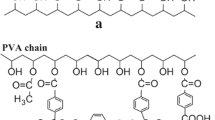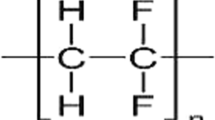Abstract
Poly(N-vinylcaprolactam-co-hydroxyethyl acrylate-co-phenyl vinyl sulfide) (poly(VC-co-HEA-co-PVS)) and poly(N-vinylcaprolactam-co-N-vinylpyrrolidone-co-phenyl vinyl sulfide) (poly(VC-co-VP-co-PVS)) were synthesized as thermos-sensitive oxidizable terpolymers. The copolymerization was confirmed by the 1H-NMR and FT-IR spectroscopy. VC homopolymer exhibited its lower critical solution temperature (LCST) around 32 ℃. The copolymerization of HEA with VC and of VP with VC decreased and increased the LCST of VC homopolymer, respectively. The inclusion of PVS (an oxidizable monomer) in the copolymers decreased the LCST. The PVS of the copolymers could be oxidized by H2O2, solution (0.1%), evidenced by 1H-NMR spectroscopy. Upon the oxidation, the LCST of poly(VC-co-PVS) and poly(VC-co-HEA-co-PVS) increased markedly possibly due to an increase in the hydrophilicity of PVS. However, the LCST of poly(VC-co-VP-co-PVS) was not markedly affected by the oxidation. The interface activity of poly(VC-co-PVS) and poly(VC-co-HEA-co-PVS) slightly decreased but that of poly(VC-co-VP-co-PVS) markedly increased by the oxidation. The critical micelle concentration of the copolymers was determined by a fluorescence method, and it was 0.087 to 0.105 mg/mL. The micelles of the copolymers were found as circular objects on a transmission electron microscope. The mean hydrodynamic diameters of micelles were 107.4 to 471.6 nm, depending on the polymer composition. The PVS-containing copolymers formed larger micelles than VC homopolymer, possibly because the monomer could enhance an intermolecular hydrophobic interaction due to its phenyl group.







Similar content being viewed by others
References
Pasparakis G, Vamvakaki M (2011) Multiresponsive polymers: nano-sized assemblies, stimuli-sensitive gels and smart surfaces. Polym Chem 2:1234–1248. https://doi.org/10.1039/C0PY00424C
Torchilin V (2009) Multifunctional and stimuli-sensitive pharmaceutical nanocarriers. Eur J Pharm Biopharm 71:431–444. https://doi.org/10.1016/j.ejpb.2008.09.026
Bennet D, Kim S (2014) Polymer nanoparticles for smart drug delivery. Appl Nanotechnol drug Deliv. https://doi.org/10.5772/58422
Liu D, Yang F, Xiong F, Gu N (2016) The smart drug delivery system and its clinical potential. Theranostics 6:1306. https://doi.org/10.7150/thno.14858
Dai J, Kim J (2014) Photo and thermal properties of cinnamoyl pluronic F-127. Polym Int 63:501–506. https://doi.org/10.1002/pi.4533
Karimifard S, Rezaei N, Jamshidifar E et al (2022) pH-responsive chitosan-adorned niosome nanocarriers for co-delivery of drugs for breast cancer therapy. ACS Appl Nano Mater 5:8811–8825. https://doi.org/10.1021/acsanm.2c00861
Ryu J-H, Roy R, Ventura J, Thayumanavan S (2010) Redox-sensitive disassembly of amphiphilic copolymer based micelles. Langmuir 26:7086–7092. https://doi.org/10.1021/la904437u
Ge J, Neofytou E, Cahill TJ III et al (2012) Drug release from electric-field-responsive nanoparticles. ACS Nano 6:227–233. https://doi.org/10.1021/nn203430m
Oliveira H, Pérez-Andrés E, Thevenot J et al (2013) Magnetic field triggered drug release from polymersomes for cancer therapeutics. J Control Release 169:165–170. https://doi.org/10.1016/j.jconrel.2013.01.013
Zhang X, Yang P, Dai Y et al (2013) Multifunctional Up-converting nanocomposites with smart polymer brushes gated mesopores for cell imaging and thermo/pH dual‐responsive drug controlled release. Adv Funct Mater 23:4067–4078. https://doi.org/10.1002/adfm.201300136
Darge HF, Andrgie AT, Tsai H-C, Lai J-Y (2019) Polysaccharide and polypeptide based injectable thermo-sensitive hydrogels for local biomedical applications. Int J Biol Macromol 133:545–563. https://doi.org/10.1016/j.ijbiomac.2019.04.131
Wei H, Cheng S-X, Zhang X-Z, Zhuo R-X (2009) Thermo-sensitive polymeric micelles based on poly (N-isopropylacrylamide) as drug carriers. Prog Polym Sci 34:893–910. https://doi.org/10.1016/j.progpolymsci.2009.05.002
Le M, Huang W, Chen K-F et al (2022) Upper critical solution temperature polymeric drug carriers. Chem Eng J 432:134354. https://doi.org/10.1016/j.cej.2021.134354
Han HD, Shin BC, Choi HS (2006) Doxorubicin-encapsulated thermosensitive liposomes modified with poly (N-isopropylacrylamide-co-acrylamide): drug release behavior and stability in the presence of serum. Eur J Pharm Biopharm 62:110–116. https://doi.org/10.1016/j.ejpb.2005.07.006
Caddeo C, Pucci L, Gabriele M et al (2018) Stability, biocompatibility and antioxidant activity of PEG-modified liposomes containing resveratrol. Int J Pharm 538:40–47. https://doi.org/10.1016/j.ijpharm.2017.12.047
Chen D, Xia D, Li X et al (2013) Comparative study of Pluronic® F127-modified liposomes and chitosan-modified liposomes for mucus penetration and oral absorption of cyclosporine A in rats. Int J Pharm 449:1–9. https://doi.org/10.1016/j.ijpharm.2013.04.002
Werzer O, Tumphart S, Keimel R et al (2019) Drug release from thin films encapsulated by a temperature-responsive hydrogel. Soft Matter 15:1853–1859. https://doi.org/10.1039/C8SM02529K
Qiu Y, Park K (2001) Environment-sensitive hydrogels for drug delivery. Adv Drug Deliv Rev 53:321–339. https://doi.org/10.1016/j.addr.2012.09.024
Liu J, Detrembleur C, De Pauw-Gillet M-C et al (2014) Gold nanorods coated with a thermo-responsive poly (ethylene glycol)-b-poly (N-vinylcaprolactam) corona as drug delivery systems for remotely near infrared-triggered release. Polym Chem 5:799–813. https://doi.org/10.1039/C3PY01057K
Zhao F, Wangpimool K, Kim J-C (2023) Near-infrared and Thermo-sensitive liposomes incorporating thiolated-carboxymethyl cellulose-capped gold nanoparticles and poly (N-isopropylacrylamide). Biotechnol Bioprocess Eng. https://doi.org/10.1007/s12257-022-0378-0
Sun H, Zhang Q, Li J et al (2021) Near-infrared photoactivated nanomedicines for photothermal synergistic cancer therapy. Nano Today 37:101073. https://doi.org/10.1016/j.nantod.2020.101073
An X, Zhang F, Zhu Y, Shen W (2010) Photoinduced drug release from thermosensitive AuNPs-liposome using a AuNPs-switch. Chem Commun 46:7202–7204. https://doi.org/10.1039/C0CC03142A
Sershen SR, Westcott SL, Halas NJ, West JL (2000) Temperature-sensitive polymer–nanoshell composites for photothermally modulated drug delivery. J Biomed Mater Res an off J Soc Biomater Japanese Soc Biomater Aust Soc Biomater Korean Soc Biomater 51:293–298. https://doi.org/10.1002/1097-4636(20000905)51:3%3c293::AID-JBM1%3e3.0.CO;2-T
Zhen S, Yi X, Zhao Z et al (2019) Drug delivery micelles with efficient near-infrared photosensitizer for combined image-guided photodynamic therapy and chemotherapy of drug-resistant cancer. Biomaterials 218:119330. https://doi.org/10.1016/j.biomaterials.2019.119330
Kim TH, Alle M, Park SC et al (2021) Self-assembly prepared using an ion pair of poly(ethylene imine) and (phenylthio) acetic acid as a drug carrier for oxidation, temperature, and NIR-responsive release. Chem Eng J 415:128954. https://doi.org/10.1016/j.cej.2021.128954
Rodriguez YJ, Quejada LF, Villamil JC et al (2020) Development of amphotericin B micellar formulations based on copolymers of poly (ethylene glycol) and poly (ε-caprolactone) conjugated with retinol. Pharmaceutics 12:196. https://doi.org/10.3390/pharmaceutics12030196
Salem JK, El-Nahhal IM, Salama SF (2019) Determination of the critical micelle concentration by absorbance and fluorescence techniques using fluorescein probe. Chem Phys Lett 730:445–450. https://doi.org/10.1016/j.cplett.2019.06.038
Goddard ED, Turro NJ, Kuo PL, Ananthapadmanabhan KP (1985) Fluorescence probes for critical micelle concentration determination. Langmuir 1:352–355. https://doi.org/10.1021/la00063a015
Park SC, Sharma G, Kim J-C (2022) Synthesis of temperature-responsive P(vinyl pyrrolidone-co-methyl methacrylate) micelle for controlled drug release. J Dispers Sci Technol 43:461–470. https://doi.org/10.1080/01932691.2021.2001344
Ai H, Flask C, Weinberg B et al (2005) Magnetite-loaded polymeric micelles as ultrasensitive magnetic-resonance probes. Adv Mater 17:1949–1952. https://doi.org/10.1002/adma.200401904
Li Y, Bastakoti BP, Malgras V et al (2015) Polymeric micelle assembly for the smart synthesis of mesoporous platinum nanospheres with tunable pore sizes. Angew Chemie Int Ed 54:11073–11077. https://doi.org/10.1002/adma.200401904
Marsili L, Dal Bo M, Eisele G et al (2021) Characterization of thermoresponsive poly-n-vinylcaprolactam polymers for biological applications. Polym (Basel) 13:1–15. https://doi.org/10.3390/polym13162639
Song G, Lin Y, Zhu Z et al (2015) Strong fluorescence of poly (N-vinylpyrrolidone) and its oxidized hydrolyzate. Macromol Rapid Commun 36:278–285. https://doi.org/10.1002/marc.201400516
Wienk IM, Meuleman EEB, Borneman Z et al (1995) Chemical treatment of membranes of a polymer blend: mechanism of the reaction of hypochlorite with poly(vinyl pyrrolidone). J Polym Sci Part A Polym Chem 33:49–54. https://doi.org/10.1002/pola.1995.080330105
De Maeyer L, Trachimow C, Kaatze U (1998) Entropy-driven micellar aggregation. J Phys Chem B 102:8480–8491. https://doi.org/10.1021/jp9807367
Mehta SK, Bhasin KK, Chauhan R, Dham S (2005) Effect of temperature on critical micelle concentration and thermodynamic behavior of dodecyldimethylethylammonium bromide and dodecyltrimethylammonium chloride in aqueous media. Colloids Surf Physicochem Eng Asp 255:153–157. https://doi.org/10.1016/j.colsurfa.2004.12.038
Xie L, Yang D, Lu Q et al (2020) Role of molecular architecture in the modulation of hydrophobic interactions. Curr Opin Colloid Interface Sci 47:58–69. https://doi.org/10.1016/j.cocis.2019.12.001
Demirezen DA, Yılmaz Ş, Yılmaz DD, Yıldız YŞ (2022) Green synthesis of iron oxide nanoparticles using Ceratonia siliqua L. aqueous extract: improvement of colloidal stability by optimizing synthesis parameters, and evaluation of antibacterial activity against Gram-positive and Gram-negative bacteria. Int J Mater Res 113:849–861. https://doi.org/10.1515/ijmr-2022-0037
Hasani Bijarbooneh F, Zhao Y, Kim JH et al (2013) Aqueous colloidal stability evaluated by Zeta potential measurement and resultant TiO2 for superior photovoltaic performance. J Am Ceram Soc 96:2636–2643. https://doi.org/10.1111/jace.12371
Acknowledgements
This research was supported by Basic Science Research Program through the National Research Foundation of Korea (NRF) funded by the Ministry of Education (No. 2018R1A6A1A03025582). This work was supported by the National Research Foundation of Korea(NRF) grant funded by the Korea government(MSIT) (No. 2022R1A2C2003353).
Author information
Authors and Affiliations
Corresponding author
Ethics declarations
Conflict of interest
The authors declare that they have no known competing financial interests or personal relationships that could have appeared to influence the work reported in this paper.
Additional information
Publisher’s Note
Springer Nature remains neutral with regard to jurisdictional claims in published maps and institutional affiliations.
Supplementary Information
Below is the link to the electronic supplementary material.
Rights and permissions
Springer Nature or its licensor (e.g. a society or other partner) holds exclusive rights to this article under a publishing agreement with the author(s) or other rightsholder(s); author self-archiving of the accepted manuscript version of this article is solely governed by the terms of such publishing agreement and applicable law.
About this article
Cite this article
Park, S., Son, H. & Kim, JC. Preparation of Thermo-sensitive oxidizable N-vinylcaprolactam-based terpolymers and their self-assembling property. J Polym Res 31, 57 (2024). https://doi.org/10.1007/s10965-024-03909-5
Received:
Accepted:
Published:
DOI: https://doi.org/10.1007/s10965-024-03909-5




